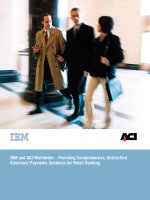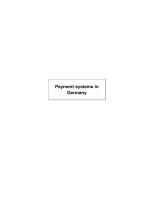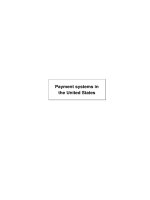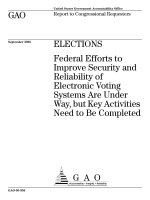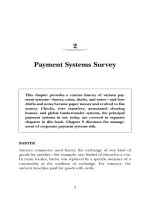Electronic payment systems
Bạn đang xem bản rút gọn của tài liệu. Xem và tải ngay bản đầy đủ của tài liệu tại đây (220.03 KB, 36 trang )
See discussions, stats, and author profiles for this publication at: />
Electronic Payment Systems
Book in EDPACS the EDP audit, control and security newsletter · January 1997
DOI: 10.1201/1079/43233.25.11.19980501/30170.7 · Source: DBLP
CITATIONS
READS
37
3,532
3 authors, including:
Donal O'Mahony
Hitesh Tewari
Trinity College Dublin
Trinity College Dublin
99 PUBLICATIONS 1,057 CITATIONS
28 PUBLICATIONS 409 CITATIONS
SEE PROFILE
SEE PROFILE
Some of the authors of this publication are also working on these related projects:
Security and Cryptography View project
Networking View project
All content following this page was uploaded by Hitesh Tewari on 14 November 2015.
The user has requested enhancement of the downloaded file.
7 Electronic Payment Systems
7.1
Traditional Payment Systems
7.2
Credit-Card Based Payment Standards
7.3
Electronic Cash and Micropayments
7.4
Practice of E- and M-Payment
Literature:
Donal O!Mahony, Michael Peirce, Hitesh Tewari: Electronic Payment
Systems for E-Commerce, 2nd ed., Artech House 2001
Thomas Lammer (Hrsg.): Handbuch E-Money, E-Payment & M-Payment,
Physica-Verlag 2006
Ludwig-Maximilians-Universität München
Prof. Hußmann
Multimedia im Netz – 7 - 1
A Brief History of Cash Money
• Direct exchange of goods
– Problematic since “double coincidence of wants” is required
• Commodity payment
– Exchange with goods of well-known value (e.g. corn, salt, gold)
– Leading to gold and silver coins
• Commodity standard
– Tokens (e.g. paper notes) which are backed by deposits of the issuer
• Fiat money
– Assuming a highly stable economy and government
– Tokens no longer (or not fully) backed by deposits
– Trust in the issuer replaces deposits
• Cash is used for 80% of all financial transactions
– Cash is not free of transaction costs!
– Replacement of coins/notes paid out of taxes
Ludwig-Maximilians-Universität München
Prof. Hußmann
Multimedia im Netz – 7 - 2
Forms of Payment
• Cash
• Cheques
– Using “clearing house” between banks
• Giro, direct credit transfer (Überweisung), direct debit (Lastschrift)
– Requires “clearing house”, today fully automated
(“Automated Clearing House ACH”)
• Wire transfer
• Payment cards (cost usually borne by the merchant):
– Credit card
» Associated with credit promise from bank
– Charge card
» Requires full settlement of bill each month
– Debit card
» Card used to initiate an immediate direct debit
Ludwig-Maximilians-Universität München
Prof. Hußmann
Multimedia im Netz – 7 - 3
Customer Preferences in Non-Cash Payment
• According to the Bank for International Settlements, www.bis.org, 2003
Country
Cheques
69.3 %
Credit
Transfer
3.7 %
Payment
Cards
25.0 %
Direct
Debit
2.0 %
USA
Netherlands
2.8 %
46.1 %
22.9 %
28.1 %
UK
34.5 %
18.5 %
29.3 %
17.7 %
Germany
5.7 %
50.1 %
4.6 %
42.6 %
Turkey
(6.9 %)
(2.6 %)
(83.9 %)
--
Country
Cheques
USA
53.5 %
Credit
Transfer
5.0 %
Payment Cards
(+ e-money cards)
38.3 %
Direct
Debit
3.1 %
Netherlands
0.2 %
38.2 %
32.4 % + 1.0 %
28.2 %
UK
23.5 %
17.7 %
39.0 %
19.7 %
Germany
2.3 %
49.8 %
11.3 % + 0.2 %
36.4 %
Turkey
--
--
--
--
2001
Ludwig-Maximilians-Universität München
Prof. Hußmann
1997 (1998)
Multimedia im Netz – 7 - 4
7 Electronic Payment Systems
7.1
Traditional Payment Systems
7.2
Credit-Card Based Payment Standards
7.3
Electronic Cash and Micropayments
7.4
Practice of E- and M-Payment
Literature:
Donal O!Mahony, Michael Peirce, Hitesh Tewari: Electronic Payment
Systems for E-Commerce, 2nd ed., Artech House 2001
Thomas Lammer (Hrsg.): Handbuch E-Money, E-Payment & M-Payment,
Physica-Verlag 2006
Ludwig-Maximilians-Universität München
Prof. Hußmann
Multimedia im Netz – 7 - 5
Credit Card MOTO Transactions
• MOTO = Mail Order/Telephone Order
• Transactions without physical co-location of buyer and merchant
• Special rules:
– Additional information
» Address
» Card security code
– Often: Matching of delivery address and credit card billing address
• Extremely popular form of online payment
– Data transfer secured by SSL, i.e. hybrid symmetric/asymmetric
cryptosystem
• Disadvantages:
– Many possibilities for fraud
– Anonymity of customer not possible
– High transaction cost – difficult for small amounts
Ludwig-Maximilians-Universität München
Prof. Hußmann
Multimedia im Netz – 7 - 6
SET
• SET = Secure Electronic Transactions
– Standard by Visa and MasterCard 1996
– Today almost without significance (after attempt to revive it in 1999)
– But still a model for a thorough way to deal with the problem
• Scope restricted to authorization of credit card payments
– No actual funds transfer
• Focus on trust model and authorization
– Using public/private key cryptosystem
• Complex (three volumes specification)
– But safe against all major risks
• Special PKI: All participants have to obtain (X.509) certificates
– “Brand Certification Authority” (MasterCard/Visa)
– Geopolitical Authority (optional)
– Cardholder/Merchant/Payment CA
Ludwig-Maximilians-Universität München
Prof. Hußmann
Multimedia im Netz – 7 - 7
SET Initialization
• Initialization (PInitReq):
– Cardholder to Merchant
– Contains: Brand of card, list of certificates, “challenge” (to ensure freshness)
• Initialization Response (PInitRes):
– Merchant to Cardholder
– Contains: Transaction ID, response to challenge, certificates, “merchant
challenge”
• Roles:
– Cardholder (Buyer)
– Merchant (Seller)
– “Acquirer” (essentially credit card organization)
» Operating a “payment gateway”
Ludwig-Maximilians-Universität München
Prof. Hußmann
Multimedia im Netz – 7 - 8
Dual Signatures
• General concept:
• Alice wants to send Message 1 to Bob and Message 2 to Carol, and she
wants to assure Bob and Carol that the respective other message exists
– To Bob she sends Message 1 and Digest 2
– To Carol she sends Message 2 and Digest 1
Message 1
Message 2
Secret Key
of Sender
Hash
Hash
Digest 1
Digest 2
Hash
Sign
Dual
Signature
Concatenation
Ludwig-Maximilians-Universität München
Prof. Hußmann
Multimedia im Netz – 7 - 9
SET Purchase
• Purchase Order (PReq):
– Cardholder to Merchant
– Order Information (OI):
» Identifies order description at the merchant
» Contains response to merchant challenge
» Includes random information (“nonce”) for protection
against dictionary attacks
– Payment instructions (PI):
» Card data, purchase amount, hash of order, transaction ID
» Payment instructions are encrypted with acquirer!s public key
(merchant cannot read it)
» “Extra strong” encryption by using RSA (and not DES, for instance)
– Dual signature for OI going to Merchant and PI going to Acquirer
Ludwig-Maximilians-Universität München
Prof. Hußmann
Multimedia im Netz – 7 - 10
SET Purchase Request Data
CardData
CC#
Expiry
Nonces
Order
Description
Amount
PIData
TransactionID
Hash(Order)
Amount
Card Data
(extra encrypted)
...
Encrypted
for Acquirer
Dual
Signature
OIData
TransactionID
BrandID
Date
Challenges
...
Ludwig-Maximilians-Universität München
Prof. Hußmann
Multimedia im Netz – 7 - 11
SET Authorization
• Authorization Request (AuthReq)
– Merchant to Acquirer
– Encrypted with Acquirer!s public key
– Signed with Merchant!s secret key
• Contains: TransactionID, amount, Hash(Order), Hash(OIData), PIData,
merchant details, cardholder billing address
– Hash(Order) contained twice
» from merchant directly
» as part of PIData (encrypted, e.g. just forwarded from cardholder)
– Can be used to verify that cardholder and merchant have agreed on order
details
• Authorization Response (AuthRes)
– Acquirer to Merchant
– Contains: TransactionID, authorization code, amount, data, capture token
(to be used for actual funds transfer)
Ludwig-Maximilians-Universität München
Prof. Hußmann
Multimedia im Netz – 7 - 12
7 Electronic Payment Systems
7.1
Traditional Payment Systems
7.2
Credit-Card Based Payment Standards
7.3
Electronic Cash and Micropayments
7.4
Practice of E- and M-Payment
Literature:
Donal O!Mahony, Michael Peirce, Hitesh Tewari: Electronic Payment
Systems for E-Commerce, 2nd ed., Artech House 2001
Ludwig-Maximilians-Universität München
Prof. Hußmann
Multimedia im Netz – 7 - 13
Electronic Cash
• Many attempts have been made to transfer the advantages of cash
money to digital transactions:
– Acceptability independent of transaction amount
– Guaranteed payment – no risk of later cancellation
– No transaction charges
» no authorization, no respective communications traffic
– Anonymity
• There does not exist an electronic system which captures all of the
above attributes!
– But there are interesting approximations...
Ludwig-Maximilians-Universität München
Prof. Hußmann
Multimedia im Netz – 7 - 14
DigiCash / Ecash
• DigiCash (David Chaum)
– Dutch/U.S. company, 1992
• Ecash
– Electronic equivalent of cash, developed by DigiCash
– Fully anonymous using cryptographic techniques
• History:
–
–
–
–
1995: Mark Twain Bank, Missouri, started issuing real Ecash dollar coins
1998: DigiCash bankruptcy
Relaunch as “eCash Technologies”
2002: eCash Technologies taken over by InfoSpace
» Mainly to acquire valuable patents
• Ecash still an interesting model for electronic cash
Ludwig-Maximilians-Universität München
Prof. Hußmann
Multimedia im Netz – 7 - 15
Ecash Model
Ecash Bank
Withdraw/
deposit coins
Validity indication
New coins,
statement
Deposit coins
Pay with coins
Client Wallet
Merchant Software
Goods
“cyberwallet”
Ludwig-Maximilians-Universität München
Prof. Hußmann
Multimedia im Netz – 7 - 16
Minting Electronic Coins
• Each coin has a serial number
– Serial number is generated by a client!s “cyberwallet” software
– Randomly chosen, large enough to avoid frequent duplicates (e.g. 100 bits)
• Coins, respectively their serial numbers, are signed by the bank
– Bank does not know the serial number through “blinding” (see next slide)
– Bank is not able to trace which coins are given to which person
• Bank uses different keys for different coin values
– E.g. 5-cent, 10-cent, 50-cent signatures
• Contents of an electronic coin:
– Serial number SN
– Key version (can be used to obtain value, currency, expiry date)
– Signature: F(SN), encrypted with one of the bank!s secret keys
» Where F computes a hash code of SN and adds some redundant
information – to avoid forging of coins
Ludwig-Maximilians-Universität München
Prof. Hußmann
Multimedia im Netz – 7 - 17
Blinding
• General concept:
• Alice wants Bob to sign a message without Bob seeing the content.
• Analogy: Envelope with message and a sheet of carbon paper
– Signature on the outside of the envelope goes through to the contained
message
• Procedure:
–
–
–
–
Blinding achieved by multiplication with random value (blinding factor)
Alice sends multiplied (blinded) message B(M) to Bob
Bob signs blinded message: SignBob(B(M))
Signature function and blinding (multiplication) are commutative:
» SignX(B(M)) = B(SignX(M))
– Alice de-blinds message (by division with blinding factor)
– The resulting message is SignBob(M), indistinguishable from a message
directly signed by Bob
Ludwig-Maximilians-Universität München
Prof. Hußmann
Multimedia im Netz – 7 - 18
Avoiding Forged Coins
• Assuming the function F was omitted
– Coin contains serial number SN in plaintext
– Signature is just SK$1(SN)
• Forging a coin:
–
–
–
–
Choose a large random number R
Encrypt R with bank!s $1 public key: S = PK$1(R)
Construct coins which contain S as serial number and R as signature
Now the coin can be verified (not distinguishable from real coin):
SK$1(S) = SK$1(PK$1(R)) = R
– Therefore introduction of function F in coin definition
Ludwig-Maximilians-Universität München
Prof. Hußmann
Multimedia im Netz – 7 - 19
Avoiding Double Spending
• E-Coins are just pieces of data which can be copied
– How to avoid that the same coin is spent several times?
• Ecash solution:
– Central database of spent coins
– Merchants must have an online connection with the Ecash bank
– Before accepting a coin: check whether it has been spent already
• Problem:
– Database of spent coins can become a performance bottleneck
– Offline trade with coins is impossible
Ludwig-Maximilians-Universität München
Prof. Hußmann
Multimedia im Netz – 7 - 20
An Ecash Purchase
• Client has Ecash coins stored in his cyberwallet
• Merchant receives an order from the client
• Merchant sends a payment request to the client!s cyberwallet
– Amount, timestamp, order description, ...
• User is asked whether he/she wants to pay
• Coins for the (exact) amount are taken from wallet
– There is no change with Ecash
– Otherwise the merchant could record the serial numbers of his coins given to
the client and try to identify the client
• Coins are encrypted with bank!s public key when sent to merchant
– Merchant just forwards them but cannot read anything
• To prove the payment:
– Client generates a secret and includes (a hash of) it into the payment info.
Ludwig-Maximilians-Universität München
Prof. Hußmann
Multimedia im Netz – 7 - 21
The Perfect Crime
Bruce Schneier:
• An anonymous kidnapper takes a hostage.
• Kidnapper prepares a large number of blinded coins and sends them to
the bank as a ransom demand.
• Bank signs the coins to save the hostage.
• Kidnapper demands that the signed coins are published, e.g. in
newspaper or television. Pickup cannot be traced. Nobody else can
unblind the coins but the kidnapper.
• Kidnapper saves the blinded coins to his computer, unblinds them, and
has a fortune in anonymous digital cash
• Hopefully, kidnapper releases the hostage...
Ludwig-Maximilians-Universität München
Prof. Hußmann
Multimedia im Netz – 7 - 22
Off-Line Coins
• Chaum/Pedersen 1992, Stefan Brands 1993:
– Coins may consist of several parts
– To use a coin in a payment transaction, one part of the coin must be
revealed. Payer is not identified.
– If the coin is used a second time, a second part of the coin is revealed – and
the payer is identified.
– This way, it is possible to trace double spendings after the fact, and to
identify the origin of the double-spent coins.
• Algorithmic idea:
– Identity I of user is encrypted with one-time random number P
» Is part of coin
– Special challenge-response system: Merchant asks client for answer on a
random challenge and stores the results
– As soon as the merchant has two results for different challenges, he can
calculate the information required to decrypt the identity of the payer
Ludwig-Maximilians-Universität München
Prof. Hußmann
Multimedia im Netz – 7 - 23
Macropayments and Micropayments
• Systems described above were designed for “macropayments”
– Minimum granularity 1 cent (penny, etc)
• Prices for services often quoted in smaller quantities
– See petrol prices...
– Hundredth or thousandth of cent
• Micropayment:
– Payment technology suitable for very small amounts
• Problem:
– Transaction overhead from macropayment systems larger than value
• Advantage:
– Losing an electronic micro-coin is not a serious damage
• Light-weight, fast, scalable protocols
• Historic pioneer: Millicent project (1995)
– Digital Equipment Corporation (taken over by Compaq, now part of HP)
– Key innovations: Brokers intermediating between vendors and scrip
(digital cash valid only for a specific vendor)
Ludwig-Maximilians-Universität München
Prof. Hußmann
Multimedia im Netz – 7 - 24

